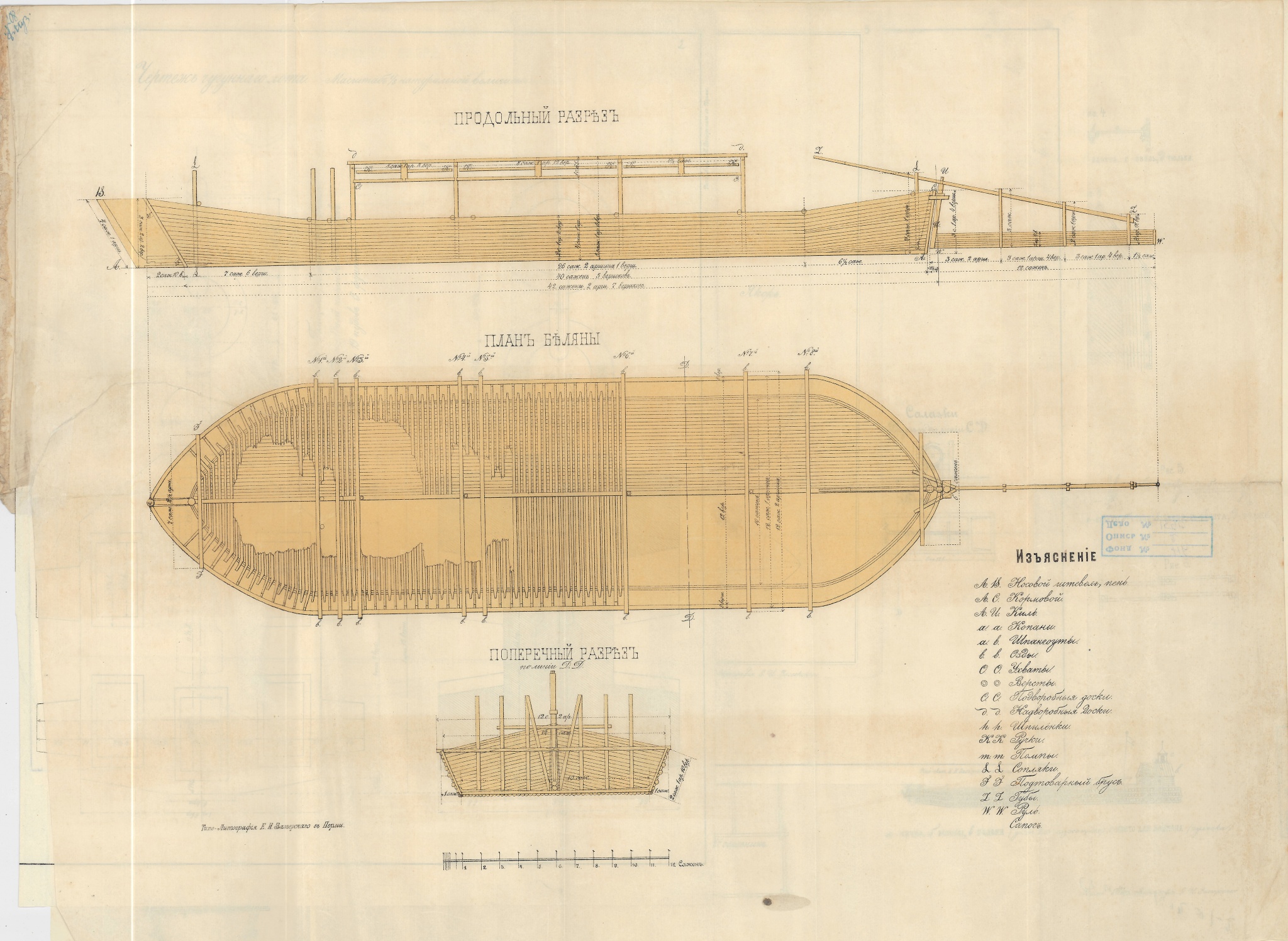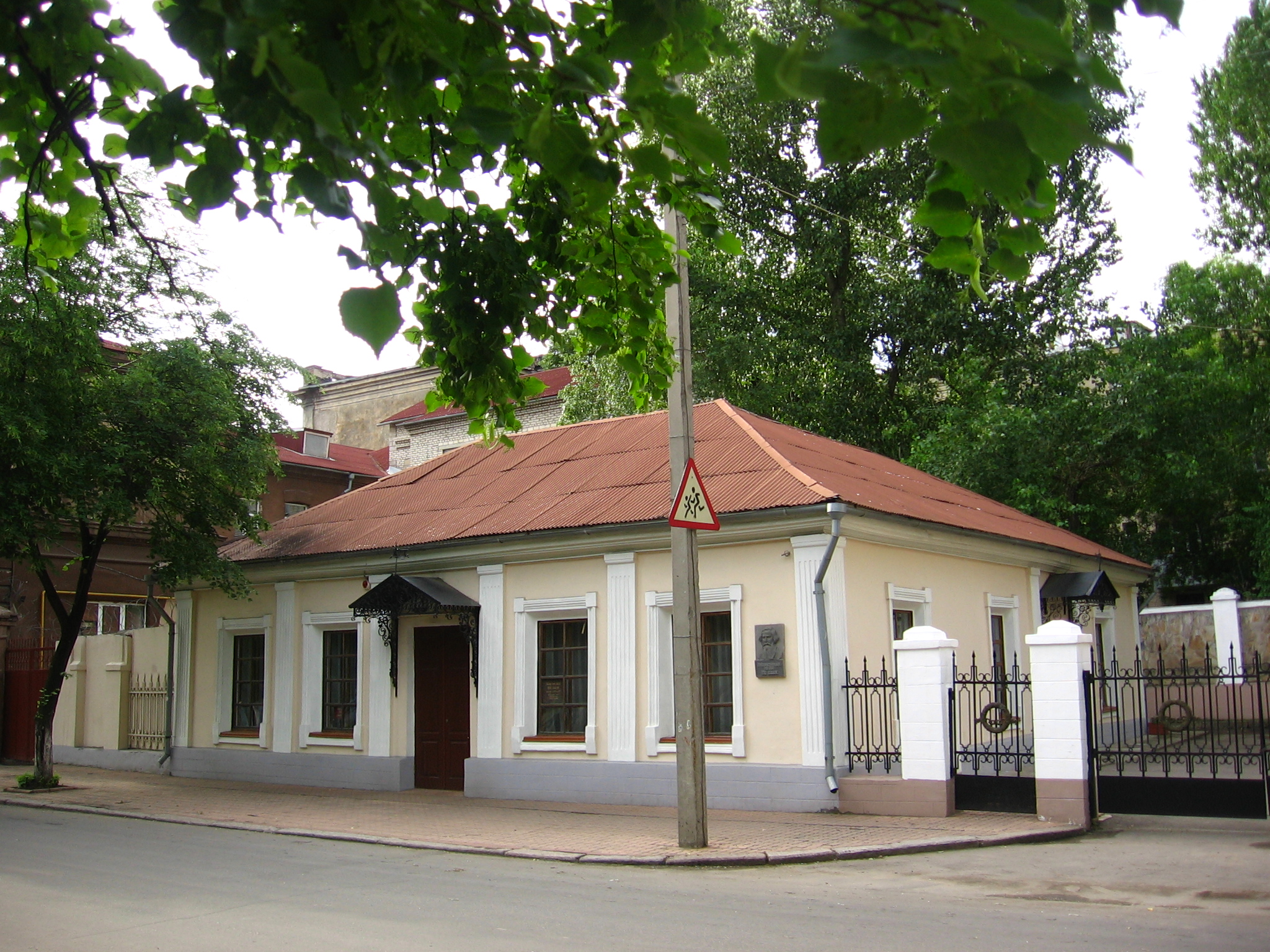|
Belyana 05
A belyana (russian: Беляна) is a type of large disposable ship that was used for timber rafting along the rivers Volga and Kama from the end of the 16th century until the middle of the 20th century. Belyanas were among the largest wooden ships ever built, with the largest ones being up to long with a load capacity up to 12,800 tons. Belyanas were built in the Upper Volga region of Russia without any special tools or plans. Never motorized, after 1870 they also had no sails and could only float downriver, using specialized anchors to turn and stop. Each year in the 18th and 19th centuries hundreds of belyanas were built and floated to Astrakhan, where they were entirely dismantled and the wood sold. With the development of railroads in the Soviet Union, belyanas became too complex and too expensive; the last belyana was built in 1939. In 2015 tourists found the remains of a wooden ship in the Vetluga river; archaeologists determined that it was an 80-meter-long belyana tha ... [...More Info...] [...Related Items...] OR: [Wikipedia] [Google] [Baidu] |
Disposable Ship
A disposable ship, also called raft ship, timber ship, or timber drogher is a ship or sea vessel that is intended for use on a single voyage. At the final destination, the vessel is broken up for sale or reuse of materials. Until the end of the 19th century, such ships were common on major rivers such as the Danube and the Rhine in Central Europe and the Mississippi in North America. There were also saltwater vessels that were primarily built for one-time sailing to break up. Some of the largest wooden ships in history were of this type. Downstream navigation On all major navigable rivers around the world, there is a current that flows towards the estuary, so it is possible to float with the water flow, and the only instruments needed are anchors and rudders to maneuver the vessel down the river. It became possible to sail upstream with the advent of steam power, without which vessels had to use sails if the current was not too strenuous, or manual force in the form of ox or ... [...More Info...] [...Related Items...] OR: [Wikipedia] [Google] [Baidu] |
Stalingrad
Volgograd ( rus, Волгогра́д, a=ru-Volgograd.ogg, p=vəɫɡɐˈɡrat), geographical renaming, formerly Tsaritsyn (russian: Цари́цын, Tsarítsyn, label=none; ) (1589–1925), and Stalingrad (russian: Сталингра́д, Stalingrád, label=none; ) (1925–1961), is the largest city and the administrative centre of Volgograd Oblast, Russia. The city lies on the western bank of the Volga, covering an area of , with a population of slightly over 1 million residents. Volgograd is the List of cities and towns in Russia by population, sixteenth-largest city by population size in Russia, the second-largest city of the Southern Federal District, and the Volga#Biggest cities on the shores of the Volga, fourth-largest city on the Volga. The city was founded as the fortress of ''Tsaritsyn'' in 1589. By the nineteenth century, Tsaritsyn had become an important river-port and commercial centre, leading to its population to grow rapidly. In November 1917, at the start of th ... [...More Info...] [...Related Items...] OR: [Wikipedia] [Google] [Baidu] |
Cheboksary
Cheboksary (; russian: Чебокса́ры, r=Cheboksáry, p=tɕɪbɐˈksarɨ; cv, Шупашкар, ''Şupaşkar'') is the capital city of Chuvashia, Russia and a port on the Volga River. Geography The city is located in the Volga Upland region and stands on the shore of the Cheboksary Reservoir. Its area is .Resolution #2083 The satellite city of Novocheboksarsk is located about east of Cheboksary. History Cheboksary was first mentioned in written sources in 1469, but according to archaeological excavations, the area had been populated much earlier. The site hosted a Bulgarian city of Veda Suvar, which appeared after Mongols defeated major Volga Bulgarian cities in the 13th century. During Khanate period the town is believed by some to have had a Turkic (probably, Tatar) name Çabaqsar and that the current Russian and English names originate from it. However, in maps by European travelers it was marked as Cibocar (Pizzigano, 1367), Veda-Suar (Fra Mauro, 1459). Shupashkar, ... [...More Info...] [...Related Items...] OR: [Wikipedia] [Google] [Baidu] |
Volga (Travel Poster)
The Volga (; russian: Во́лга, a=Ru-Волга.ogg, p=ˈvoɫɡə) is the longest river in Europe. Situated in Russia, it flows through Central Russia to Southern Russia and into the Caspian Sea. The Volga has a length of , and a catchment area of «Река Волга» , Russian State Water Registry. It is also Europe's largest river in terms of average discharge at delta – between and – and of . It is widely regarded as the national river of |
Steamboat
A steamboat is a boat that is marine propulsion, propelled primarily by marine steam engine, steam power, typically driving propellers or Paddle steamer, paddlewheels. Steamboats sometimes use the ship prefix, prefix designation SS, S.S. or S/S (for 'Screw Steamer') or PS (for 'Paddle Steamer'); however, these designations are most often used for steamships. The term ''steamboat'' is used to refer to smaller, insular, steam-powered boats working on lakes and rivers, particularly riverboats. As using steam became more reliable, steam power became applied to larger, ocean-going vessels. Background Limitations of the Newcomen steam engine Early steamboat designs used Newcomen atmospheric engine, Newcomen steam engines. These engines were large, heavy, and produced little power, which resulted in an unfavorable power-to-weight ratio. The Newcomen engine also produced a reciprocating or rocking motion because it was designed for pumping. The piston stroke was caused by a water jet i ... [...More Info...] [...Related Items...] OR: [Wikipedia] [Google] [Baidu] |
Burlak
A burlak ( rus, бурла́к, p=bʊrˈlak) was a towpath puller in Russian Empire. Overview The exact origin of the word is unknown. Different versions include old middle-German ''bûrlach'' (working team with fixed rules, artel), or Tatar ''bujdak'', 'homeless'. Burlaks appeared in Russia at the end of 16th century and beginning of the 17th century. With the expansion of freight-hauling, the number of burlaks increased. The chief of a burlak gang was called ''Vodoliv'' (russian: Водолив), the next in line was the ''Dyadya'' (russian: Дядя, captain), followed by the ''Shishka'' (russian: Шишка, first in the line of haulers), while the last in line was called ''Kosny'' (russian: Косный, last in the line of haulers). There were ''seasonal'' burlaks, who worked from spring to autumn, and ''temporary'' burlaks, who worked occasionally. Burlaks did not work in winter, when most Russian rivers were frozen over. The main areas of the burlaks' trade in the Rus ... [...More Info...] [...Related Items...] OR: [Wikipedia] [Google] [Baidu] |
Caspian Sea
The Caspian Sea is the world's largest inland body of water, often described as the world's largest lake or a full-fledged sea. An endorheic basin, it lies between Europe and Asia; east of the Caucasus, west of the broad steppe of Central Asia, south of the fertile plains of Southern Russia in Eastern Europe, and north of the mountainous Iranian Plateau of Western Asia. It covers a surface area of (excluding the highly saline lagoon of Garabogazköl to its east) and a volume of . It has a salinity of approximately 1.2% (12 g/L), about a third of the salinity of average seawater. It is bounded by Kazakhstan to the northeast, Russia to the northwest, Azerbaijan to the southwest, Iran to the south, and Turkmenistan to the southeast. The sea stretches nearly from north to south, with an average width of . Its gross coverage is and the surface is about below sea level. Its main freshwater inflow, Europe's longest river, the Volga, enters at the shallow north end. Two deep ... [...More Info...] [...Related Items...] OR: [Wikipedia] [Google] [Baidu] |
Tsaritsyn
Volgograd ( rus, Волгогра́д, a=ru-Volgograd.ogg, p=vəɫɡɐˈɡrat), formerly Tsaritsyn (russian: Цари́цын, Tsarítsyn, label=none; ) (1589–1925), and Stalingrad (russian: Сталингра́д, Stalingrád, label=none; ) (1925–1961), is the largest city and the administrative centre of Volgograd Oblast, Russia. The city lies on the western bank of the Volga, covering an area of , with a population of slightly over 1 million residents. Volgograd is the sixteenth-largest city by population size in Russia, the second-largest city of the Southern Federal District, and the fourth-largest city on the Volga. The city was founded as the fortress of ''Tsaritsyn'' in 1589. By the nineteenth century, Tsaritsyn had become an important river-port and commercial centre, leading to its population to grow rapidly. In November 1917, at the start of the Russian Civil War, Tsaritsyn came under Bolshevik control. It fell briefly to the White Army in mid-1919 but Battle o ... [...More Info...] [...Related Items...] OR: [Wikipedia] [Google] [Baidu] |
Saratov
Saratov (, ; rus, Сара́тов, a=Ru-Saratov.ogg, p=sɐˈratəf) is the largest city and administrative center of Saratov Oblast, Russia, and a major port on the Volga River upstream (north) of Volgograd. Saratov had a population of 901,361, making it the 17th-largest city in Russia by population. Saratov is from Volgograd, from Samara, and southeast of Moscow. The city stands near the site of Uvek, a city of the Golden Horde. Tsar Feodor I of Russia likely developed Saratov as a fortress to secure Russia's southeastern border. Saratov developed as a shipping port along the Volga and was historically important to the Volga Germans, who settled in large numbers in the city before they were expelled after World War II. Saratov is home to a number of cultural and educational institutions, including the Saratov Drama Theater, Saratov Conservatory, Radishchev Art Museum, Saratov State Technical University, and Saratov State University. Etymology The name Sarat ... [...More Info...] [...Related Items...] OR: [Wikipedia] [Google] [Baidu] |
Explanatory Dictionary Of The Living Great Russian Language
The ''Explanatory Dictionary of the Living Great Russian Language'' (russian: link=no, Толко́вый слова́рь живо́го великору́сского языка́), commonly known as ''Dal's Explanatory Dictionary'' (russian: Толко́вый слова́рь Да́ля, links=no), is a major explanatory dictionary of the Russian language. It contains about 220,000 words and 30,000 proverbs (3rd edition). It was collected, edited and published by academician Vladimir Ivanovich Dal (russian: Влади́мир Ива́нович Даль, links=no; 1801–1872), one of the most prominent Russian language lexicographers and folklore collectors of the 19th century. ''Dal's Explanatory Dictionary'' of the Great Russian language was the only substantial dictionary printed repeatedly (1935, 1955) in the Soviet Union in compliance with the old rules of spelling and alphabet, which were repealed in 1918. History and features The author shows his specific understa ... [...More Info...] [...Related Items...] OR: [Wikipedia] [Google] [Baidu] |
Vladimir Dal
Vladimir Ivanovich Dal ( rus, Влади́мир Ива́нович Даль, p=vlɐˈdʲimʲɪr ɨˈvanəvʲɪdʑ ˈdalʲ; November 22, 1801 – October 4, 1872) was a noted Russian-language lexicographer, polyglot, Turkologist, and founding member of the Russian Geographical Society. During his lifetime he compiled and documented the oral history of the region that was later published in Russian and became part of modern folklore. Early life Vladimir Dal's father was a Danish physician named Johan Christian von Dahl (1764 – October 21, 1821), a linguist versed in the German, English, French, Russian, Yiddish, Latin, Greek and Hebrew languages. His mother, Julia Adelaide Freytag, had German and probably French (Huguenot) ancestry; she spoke at least five languages and came from a family of scholars. The future lexicographer was born in the town of Lugansky Zavod (present-day Luhansk, Ukraine), in Novorossiya - then under the jurisdiction of Yekaterinoslav Governorate, part ... [...More Info...] [...Related Items...] OR: [Wikipedia] [Google] [Baidu] |


_(1857).png)






